Networking RQF L4 Report: Network Infrastructure for sys-go.co.uk
VerifiedAdded on 2020/06/04
|20
|5055
|181
Report
AI Summary
This report provides a comprehensive overview of networking principles, focusing on the design and implementation of a new network infrastructure for sys-go.co.uk. It begins by examining various network types, including LAN, WAN, and MAN, along with their respective benefits and constraints. The report then delves into network standards, topologies (bus, star, ring), communication methods, and bandwidth requirements, analyzing their impact on network performance. Furthermore, it explores the operating principles of networking devices and server types (web, DNS, email, file servers), essential for designing a robust network. The report also considers the interdependence of workstation hardware and networking software. The design includes a detailed description of LAN technology and topology, along with a test plan to evaluate the design's ability to meet requirements, considering scalability and availability. Finally, the report outlines the implementation process, analyzes test results, and suggests a maintenance schedule, offering a complete guide to network infrastructure development.

Networking (RQF L4)
Paraphrase This Document
Need a fresh take? Get an instant paraphrase of this document with our AI Paraphraser
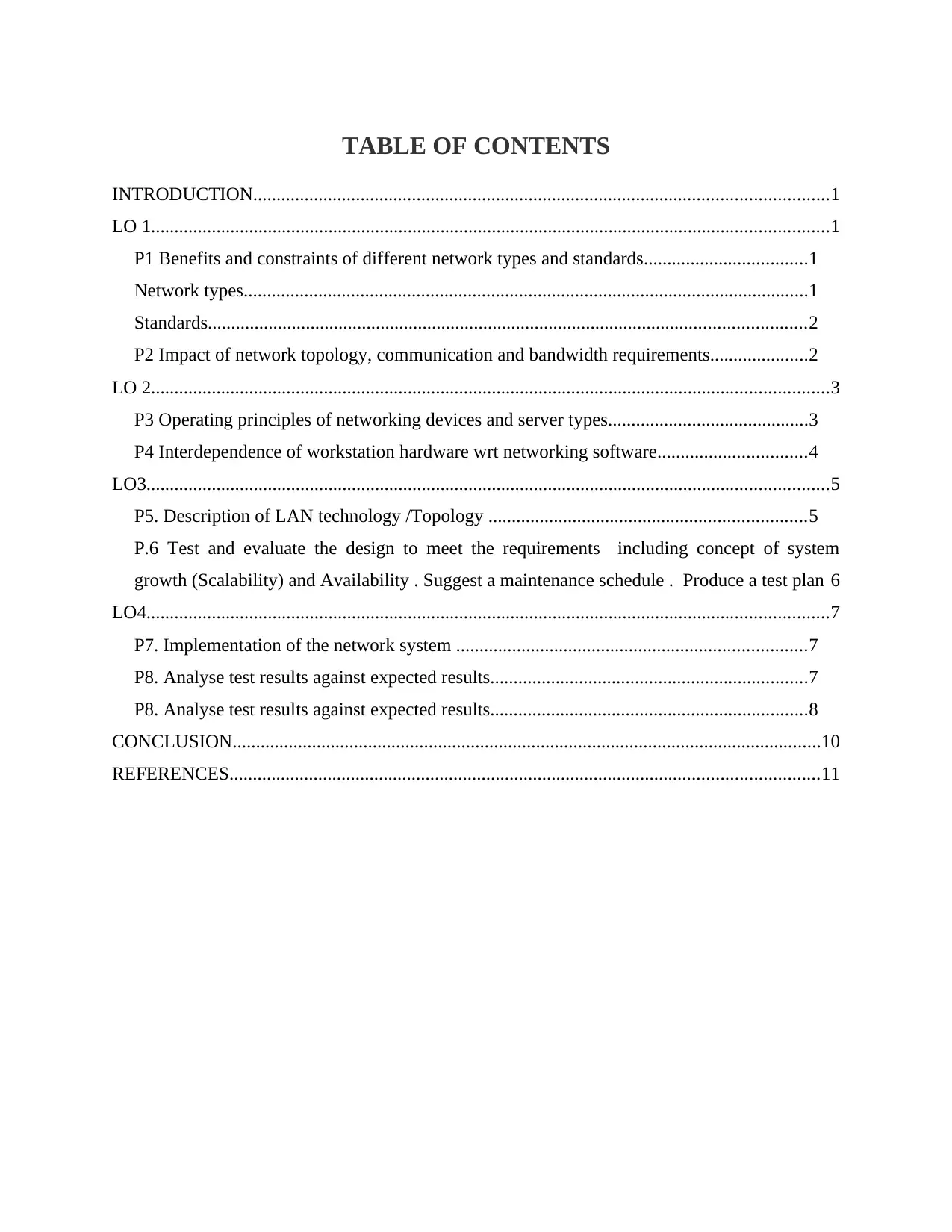
TABLE OF CONTENTS
INTRODUCTION...........................................................................................................................1
LO 1.................................................................................................................................................1
P1 Benefits and constraints of different network types and standards...................................1
Network types.........................................................................................................................1
Standards................................................................................................................................2
P2 Impact of network topology, communication and bandwidth requirements.....................2
LO 2.................................................................................................................................................3
P3 Operating principles of networking devices and server types...........................................3
P4 Interdependence of workstation hardware wrt networking software................................4
LO3..................................................................................................................................................5
P5. Description of LAN technology /Topology ....................................................................5
P.6 Test and evaluate the design to meet the requirements including concept of system
growth (Scalability) and Availability . Suggest a maintenance schedule . Produce a test plan 6
LO4..................................................................................................................................................7
P7. Implementation of the network system ...........................................................................7
P8. Analyse test results against expected results....................................................................7
P8. Analyse test results against expected results....................................................................8
CONCLUSION..............................................................................................................................10
REFERENCES..............................................................................................................................11
INTRODUCTION...........................................................................................................................1
LO 1.................................................................................................................................................1
P1 Benefits and constraints of different network types and standards...................................1
Network types.........................................................................................................................1
Standards................................................................................................................................2
P2 Impact of network topology, communication and bandwidth requirements.....................2
LO 2.................................................................................................................................................3
P3 Operating principles of networking devices and server types...........................................3
P4 Interdependence of workstation hardware wrt networking software................................4
LO3..................................................................................................................................................5
P5. Description of LAN technology /Topology ....................................................................5
P.6 Test and evaluate the design to meet the requirements including concept of system
growth (Scalability) and Availability . Suggest a maintenance schedule . Produce a test plan 6
LO4..................................................................................................................................................7
P7. Implementation of the network system ...........................................................................7
P8. Analyse test results against expected results....................................................................7
P8. Analyse test results against expected results....................................................................8
CONCLUSION..............................................................................................................................10
REFERENCES..............................................................................................................................11
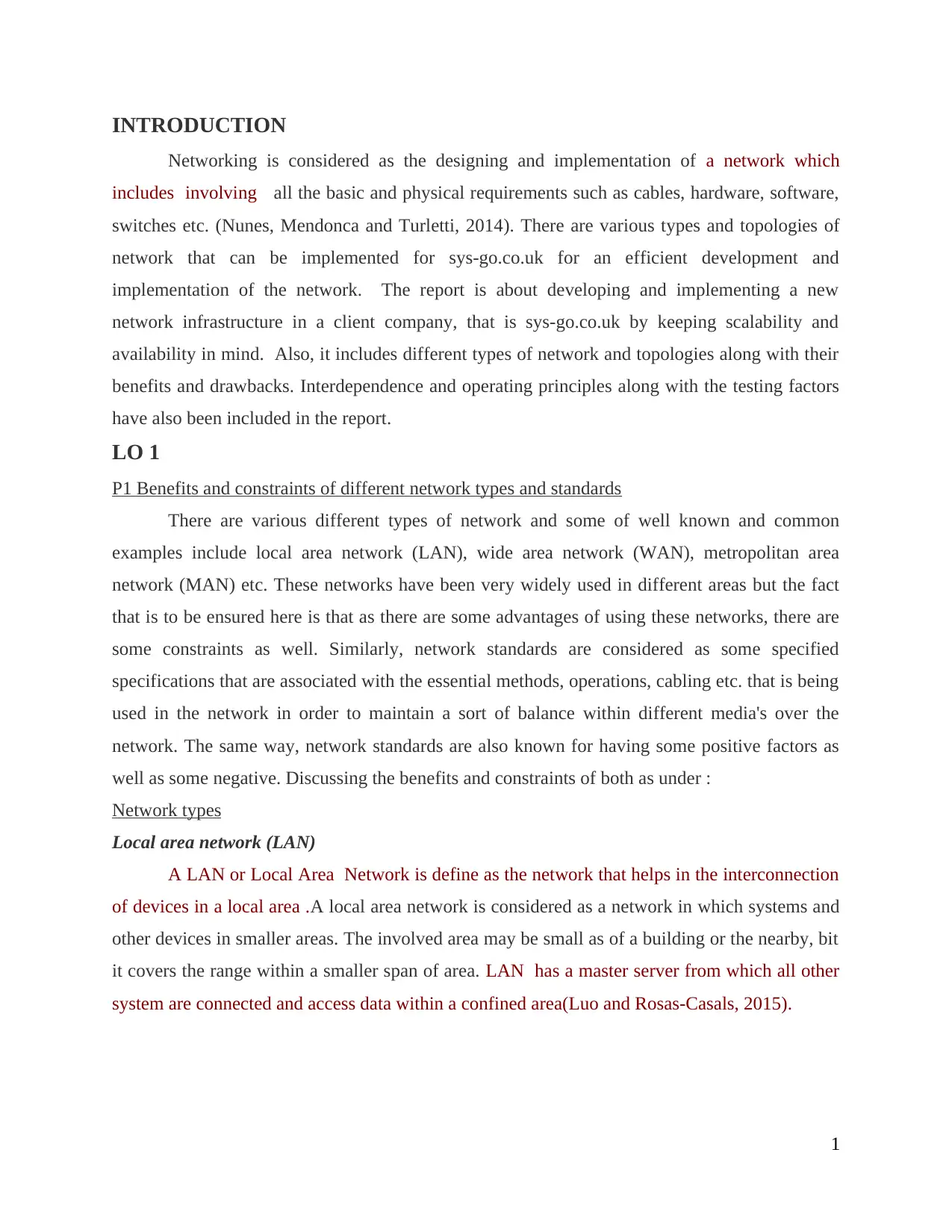
INTRODUCTION
Networking is considered as the designing and implementation of a network which
includes involving all the basic and physical requirements such as cables, hardware, software,
switches etc. (Nunes, Mendonca and Turletti, 2014). There are various types and topologies of
network that can be implemented for sys-go.co.uk for an efficient development and
implementation of the network. The report is about developing and implementing a new
network infrastructure in a client company, that is sys-go.co.uk by keeping scalability and
availability in mind. Also, it includes different types of network and topologies along with their
benefits and drawbacks. Interdependence and operating principles along with the testing factors
have also been included in the report.
LO 1
P1 Benefits and constraints of different network types and standards
There are various different types of network and some of well known and common
examples include local area network (LAN), wide area network (WAN), metropolitan area
network (MAN) etc. These networks have been very widely used in different areas but the fact
that is to be ensured here is that as there are some advantages of using these networks, there are
some constraints as well. Similarly, network standards are considered as some specified
specifications that are associated with the essential methods, operations, cabling etc. that is being
used in the network in order to maintain a sort of balance within different media's over the
network. The same way, network standards are also known for having some positive factors as
well as some negative. Discussing the benefits and constraints of both as under :
Network types
Local area network (LAN)
A LAN or Local Area Network is define as the network that helps in the interconnection
of devices in a local area .A local area network is considered as a network in which systems and
other devices in smaller areas. The involved area may be small as of a building or the nearby, bit
it covers the range within a smaller span of area. LAN has a master server from which all other
system are connected and access data within a confined area(Luo and Rosas-Casals, 2015).
1
Networking is considered as the designing and implementation of a network which
includes involving all the basic and physical requirements such as cables, hardware, software,
switches etc. (Nunes, Mendonca and Turletti, 2014). There are various types and topologies of
network that can be implemented for sys-go.co.uk for an efficient development and
implementation of the network. The report is about developing and implementing a new
network infrastructure in a client company, that is sys-go.co.uk by keeping scalability and
availability in mind. Also, it includes different types of network and topologies along with their
benefits and drawbacks. Interdependence and operating principles along with the testing factors
have also been included in the report.
LO 1
P1 Benefits and constraints of different network types and standards
There are various different types of network and some of well known and common
examples include local area network (LAN), wide area network (WAN), metropolitan area
network (MAN) etc. These networks have been very widely used in different areas but the fact
that is to be ensured here is that as there are some advantages of using these networks, there are
some constraints as well. Similarly, network standards are considered as some specified
specifications that are associated with the essential methods, operations, cabling etc. that is being
used in the network in order to maintain a sort of balance within different media's over the
network. The same way, network standards are also known for having some positive factors as
well as some negative. Discussing the benefits and constraints of both as under :
Network types
Local area network (LAN)
A LAN or Local Area Network is define as the network that helps in the interconnection
of devices in a local area .A local area network is considered as a network in which systems and
other devices in smaller areas. The involved area may be small as of a building or the nearby, bit
it covers the range within a smaller span of area. LAN has a master server from which all other
system are connected and access data within a confined area(Luo and Rosas-Casals, 2015).
1
⊘ This is a preview!⊘
Do you want full access?
Subscribe today to unlock all pages.

Trusted by 1+ million students worldwide
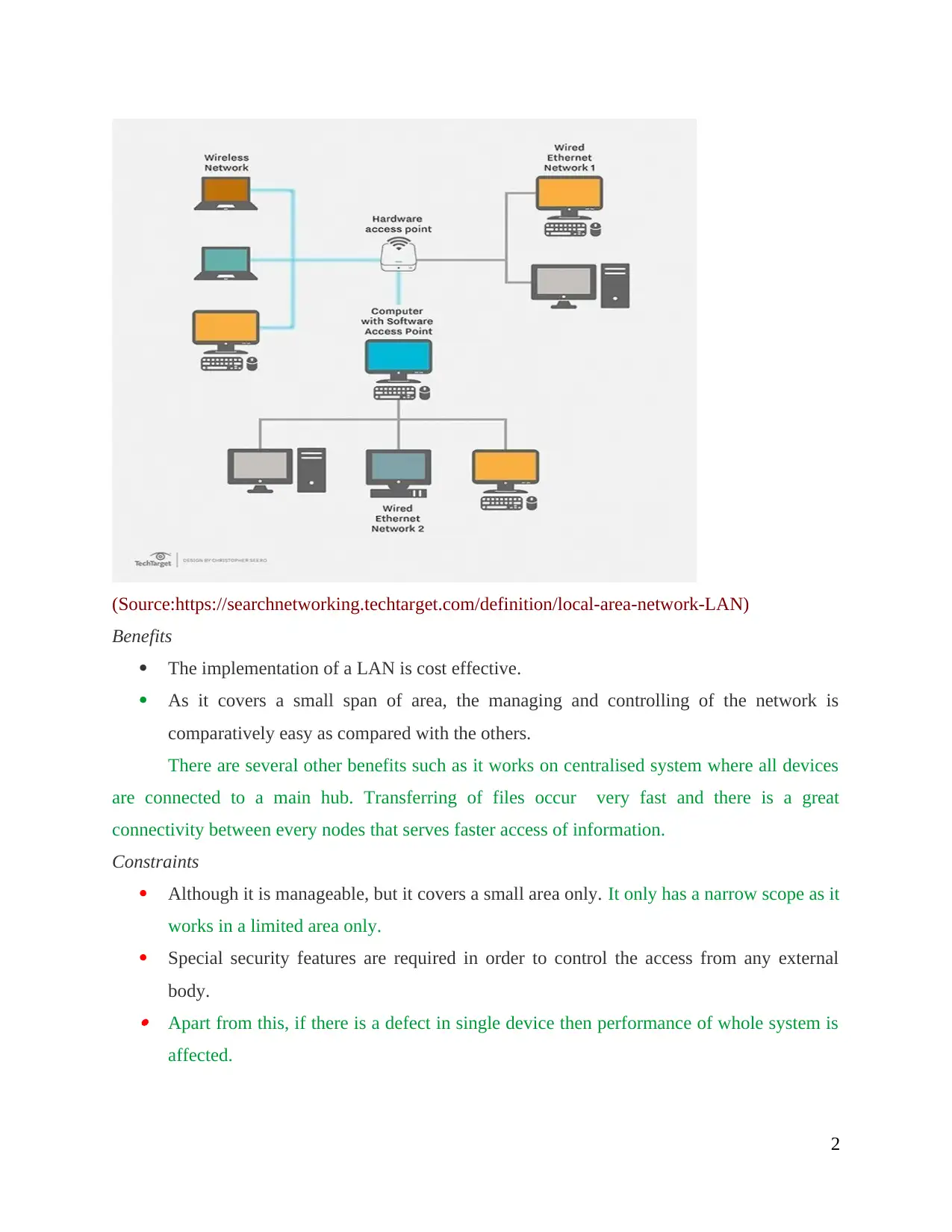
(Source:https://searchnetworking.techtarget.com/definition/local-area-network-LAN)
Benefits
The implementation of a LAN is cost effective.
As it covers a small span of area, the managing and controlling of the network is
comparatively easy as compared with the others.
There are several other benefits such as it works on centralised system where all devices
are connected to a main hub. Transferring of files occur very fast and there is a great
connectivity between every nodes that serves faster access of information.
Constraints
Although it is manageable, but it covers a small area only. It only has a narrow scope as it
works in a limited area only.
Special security features are required in order to control the access from any external
body. Apart from this, if there is a defect in single device then performance of whole system is
affected.
2
Benefits
The implementation of a LAN is cost effective.
As it covers a small span of area, the managing and controlling of the network is
comparatively easy as compared with the others.
There are several other benefits such as it works on centralised system where all devices
are connected to a main hub. Transferring of files occur very fast and there is a great
connectivity between every nodes that serves faster access of information.
Constraints
Although it is manageable, but it covers a small area only. It only has a narrow scope as it
works in a limited area only.
Special security features are required in order to control the access from any external
body. Apart from this, if there is a defect in single device then performance of whole system is
affected.
2
Paraphrase This Document
Need a fresh take? Get an instant paraphrase of this document with our AI Paraphraser
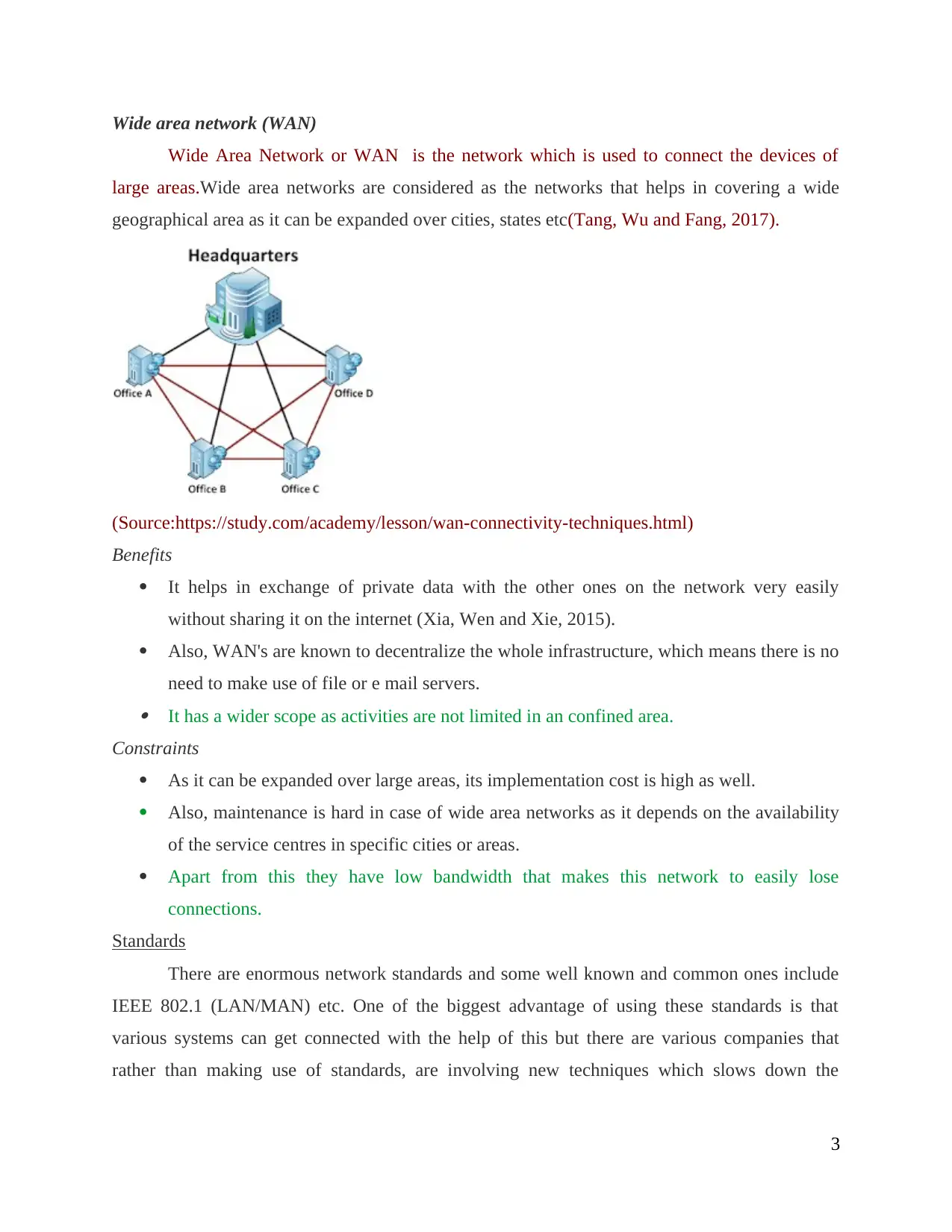
Wide area network (WAN)
Wide Area Network or WAN is the network which is used to connect the devices of
large areas.Wide area networks are considered as the networks that helps in covering a wide
geographical area as it can be expanded over cities, states etc(Tang, Wu and Fang, 2017).
(Source:https://study.com/academy/lesson/wan-connectivity-techniques.html)
Benefits
It helps in exchange of private data with the other ones on the network very easily
without sharing it on the internet (Xia, Wen and Xie, 2015).
Also, WAN's are known to decentralize the whole infrastructure, which means there is no
need to make use of file or e mail servers. It has a wider scope as activities are not limited in an confined area.
Constraints
As it can be expanded over large areas, its implementation cost is high as well.
Also, maintenance is hard in case of wide area networks as it depends on the availability
of the service centres in specific cities or areas.
Apart from this they have low bandwidth that makes this network to easily lose
connections.
Standards
There are enormous network standards and some well known and common ones include
IEEE 802.1 (LAN/MAN) etc. One of the biggest advantage of using these standards is that
various systems can get connected with the help of this but there are various companies that
rather than making use of standards, are involving new techniques which slows down the
3
Wide Area Network or WAN is the network which is used to connect the devices of
large areas.Wide area networks are considered as the networks that helps in covering a wide
geographical area as it can be expanded over cities, states etc(Tang, Wu and Fang, 2017).
(Source:https://study.com/academy/lesson/wan-connectivity-techniques.html)
Benefits
It helps in exchange of private data with the other ones on the network very easily
without sharing it on the internet (Xia, Wen and Xie, 2015).
Also, WAN's are known to decentralize the whole infrastructure, which means there is no
need to make use of file or e mail servers. It has a wider scope as activities are not limited in an confined area.
Constraints
As it can be expanded over large areas, its implementation cost is high as well.
Also, maintenance is hard in case of wide area networks as it depends on the availability
of the service centres in specific cities or areas.
Apart from this they have low bandwidth that makes this network to easily lose
connections.
Standards
There are enormous network standards and some well known and common ones include
IEEE 802.1 (LAN/MAN) etc. One of the biggest advantage of using these standards is that
various systems can get connected with the help of this but there are various companies that
rather than making use of standards, are involving new techniques which slows down the
3
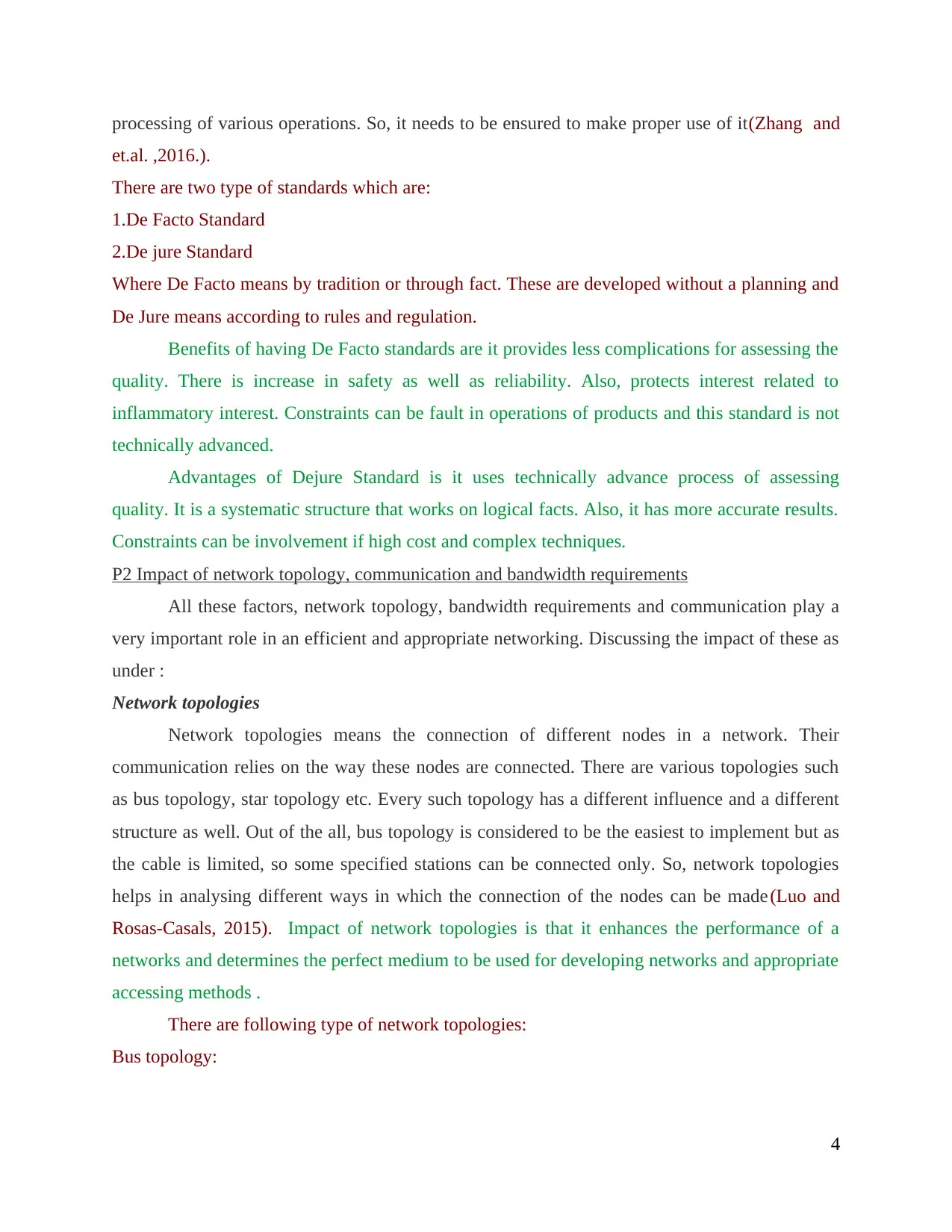
processing of various operations. So, it needs to be ensured to make proper use of it(Zhang and
et.al. ,2016.).
There are two type of standards which are:
1.De Facto Standard
2.De jure Standard
Where De Facto means by tradition or through fact. These are developed without a planning and
De Jure means according to rules and regulation.
Benefits of having De Facto standards are it provides less complications for assessing the
quality. There is increase in safety as well as reliability. Also, protects interest related to
inflammatory interest. Constraints can be fault in operations of products and this standard is not
technically advanced.
Advantages of Dejure Standard is it uses technically advance process of assessing
quality. It is a systematic structure that works on logical facts. Also, it has more accurate results.
Constraints can be involvement if high cost and complex techniques.
P2 Impact of network topology, communication and bandwidth requirements
All these factors, network topology, bandwidth requirements and communication play a
very important role in an efficient and appropriate networking. Discussing the impact of these as
under :
Network topologies
Network topologies means the connection of different nodes in a network. Their
communication relies on the way these nodes are connected. There are various topologies such
as bus topology, star topology etc. Every such topology has a different influence and a different
structure as well. Out of the all, bus topology is considered to be the easiest to implement but as
the cable is limited, so some specified stations can be connected only. So, network topologies
helps in analysing different ways in which the connection of the nodes can be made(Luo and
Rosas-Casals, 2015). Impact of network topologies is that it enhances the performance of a
networks and determines the perfect medium to be used for developing networks and appropriate
accessing methods .
There are following type of network topologies:
Bus topology:
4
et.al. ,2016.).
There are two type of standards which are:
1.De Facto Standard
2.De jure Standard
Where De Facto means by tradition or through fact. These are developed without a planning and
De Jure means according to rules and regulation.
Benefits of having De Facto standards are it provides less complications for assessing the
quality. There is increase in safety as well as reliability. Also, protects interest related to
inflammatory interest. Constraints can be fault in operations of products and this standard is not
technically advanced.
Advantages of Dejure Standard is it uses technically advance process of assessing
quality. It is a systematic structure that works on logical facts. Also, it has more accurate results.
Constraints can be involvement if high cost and complex techniques.
P2 Impact of network topology, communication and bandwidth requirements
All these factors, network topology, bandwidth requirements and communication play a
very important role in an efficient and appropriate networking. Discussing the impact of these as
under :
Network topologies
Network topologies means the connection of different nodes in a network. Their
communication relies on the way these nodes are connected. There are various topologies such
as bus topology, star topology etc. Every such topology has a different influence and a different
structure as well. Out of the all, bus topology is considered to be the easiest to implement but as
the cable is limited, so some specified stations can be connected only. So, network topologies
helps in analysing different ways in which the connection of the nodes can be made(Luo and
Rosas-Casals, 2015). Impact of network topologies is that it enhances the performance of a
networks and determines the perfect medium to be used for developing networks and appropriate
accessing methods .
There are following type of network topologies:
Bus topology:
4
⊘ This is a preview!⊘
Do you want full access?
Subscribe today to unlock all pages.

Trusted by 1+ million students worldwide
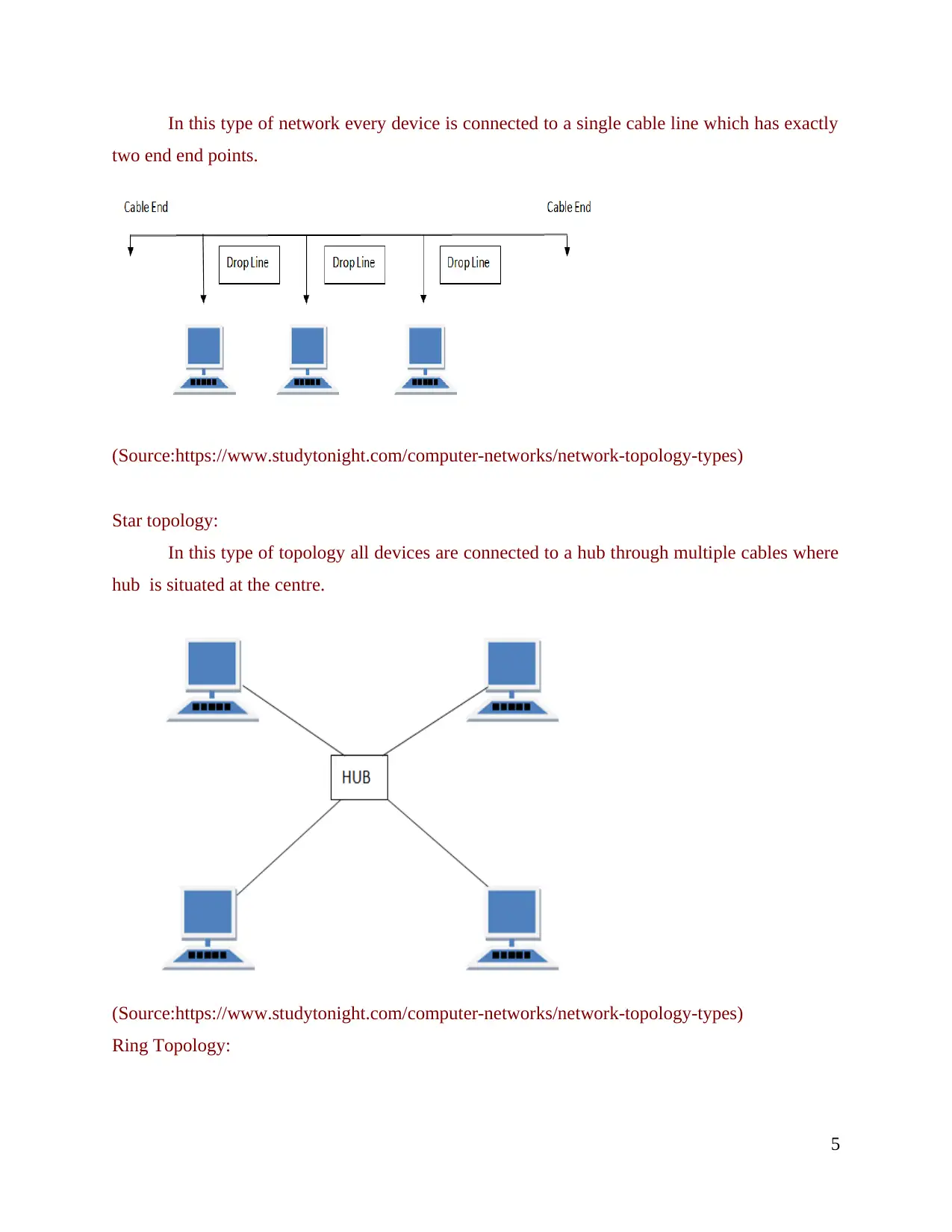
In this type of network every device is connected to a single cable line which has exactly
two end end points.
(Source:https://www.studytonight.com/computer-networks/network-topology-types)
Star topology:
In this type of topology all devices are connected to a hub through multiple cables where
hub is situated at the centre.
(Source:https://www.studytonight.com/computer-networks/network-topology-types)
Ring Topology:
5
two end end points.
(Source:https://www.studytonight.com/computer-networks/network-topology-types)
Star topology:
In this type of topology all devices are connected to a hub through multiple cables where
hub is situated at the centre.
(Source:https://www.studytonight.com/computer-networks/network-topology-types)
Ring Topology:
5
Paraphrase This Document
Need a fresh take? Get an instant paraphrase of this document with our AI Paraphraser
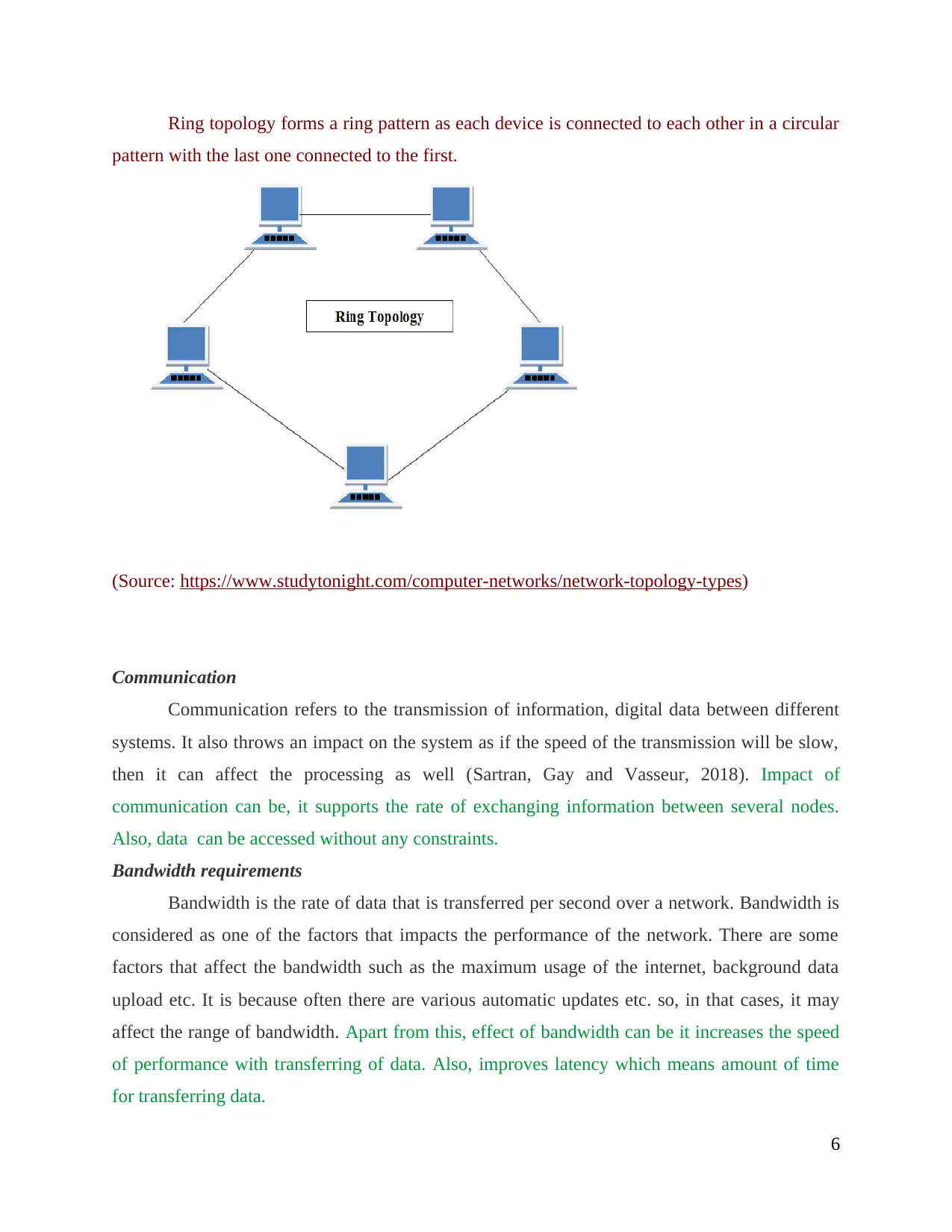
Ring topology forms a ring pattern as each device is connected to each other in a circular
pattern with the last one connected to the first.
(Source: https://www.studytonight.com/computer-networks/network-topology-types)
Communication
Communication refers to the transmission of information, digital data between different
systems. It also throws an impact on the system as if the speed of the transmission will be slow,
then it can affect the processing as well (Sartran, Gay and Vasseur, 2018). Impact of
communication can be, it supports the rate of exchanging information between several nodes.
Also, data can be accessed without any constraints.
Bandwidth requirements
Bandwidth is the rate of data that is transferred per second over a network. Bandwidth is
considered as one of the factors that impacts the performance of the network. There are some
factors that affect the bandwidth such as the maximum usage of the internet, background data
upload etc. It is because often there are various automatic updates etc. so, in that cases, it may
affect the range of bandwidth. Apart from this, effect of bandwidth can be it increases the speed
of performance with transferring of data. Also, improves latency which means amount of time
for transferring data.
6
pattern with the last one connected to the first.
(Source: https://www.studytonight.com/computer-networks/network-topology-types)
Communication
Communication refers to the transmission of information, digital data between different
systems. It also throws an impact on the system as if the speed of the transmission will be slow,
then it can affect the processing as well (Sartran, Gay and Vasseur, 2018). Impact of
communication can be, it supports the rate of exchanging information between several nodes.
Also, data can be accessed without any constraints.
Bandwidth requirements
Bandwidth is the rate of data that is transferred per second over a network. Bandwidth is
considered as one of the factors that impacts the performance of the network. There are some
factors that affect the bandwidth such as the maximum usage of the internet, background data
upload etc. It is because often there are various automatic updates etc. so, in that cases, it may
affect the range of bandwidth. Apart from this, effect of bandwidth can be it increases the speed
of performance with transferring of data. Also, improves latency which means amount of time
for transferring data.
6
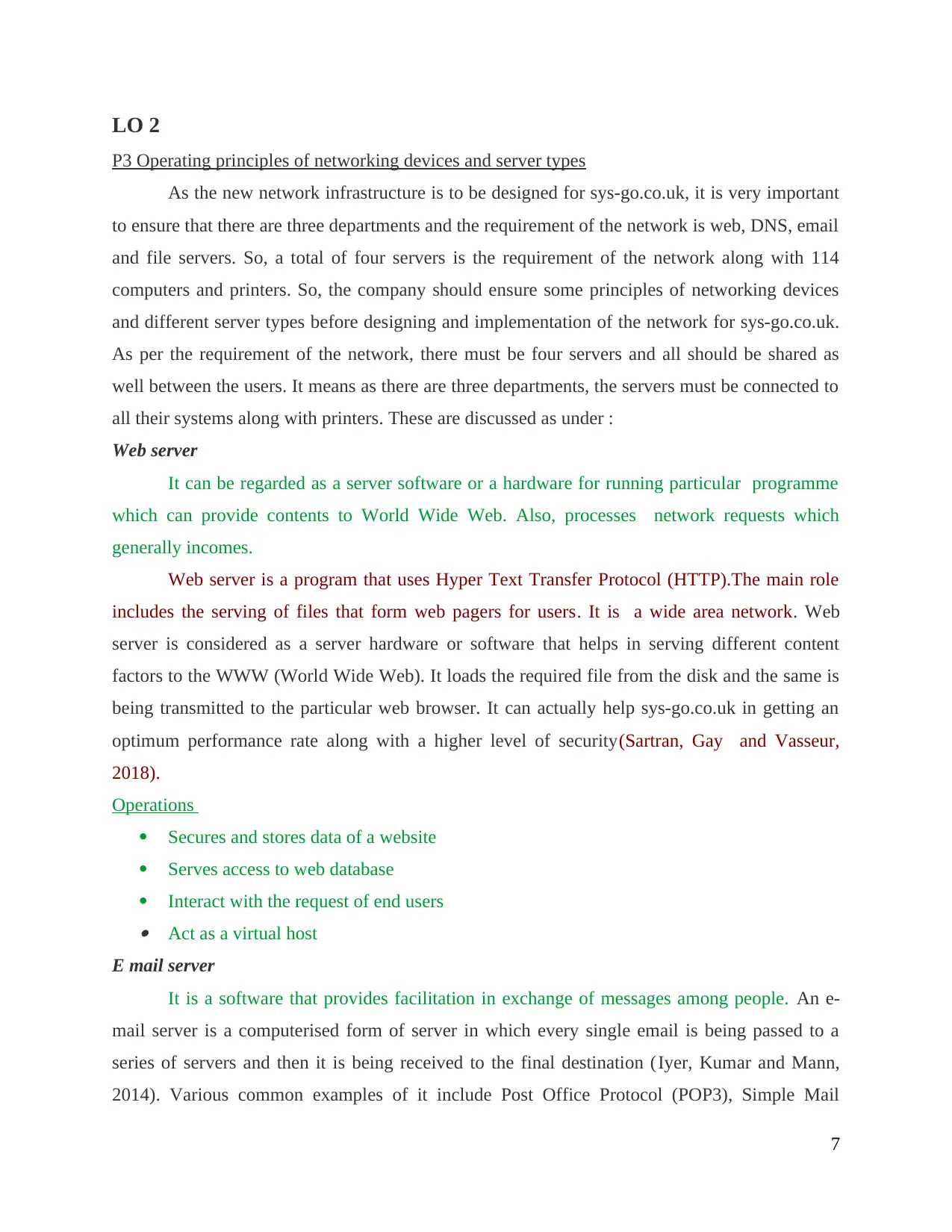
LO 2
P3 Operating principles of networking devices and server types
As the new network infrastructure is to be designed for sys-go.co.uk, it is very important
to ensure that there are three departments and the requirement of the network is web, DNS, email
and file servers. So, a total of four servers is the requirement of the network along with 114
computers and printers. So, the company should ensure some principles of networking devices
and different server types before designing and implementation of the network for sys-go.co.uk.
As per the requirement of the network, there must be four servers and all should be shared as
well between the users. It means as there are three departments, the servers must be connected to
all their systems along with printers. These are discussed as under :
Web server
It can be regarded as a server software or a hardware for running particular programme
which can provide contents to World Wide Web. Also, processes network requests which
generally incomes.
Web server is a program that uses Hyper Text Transfer Protocol (HTTP).The main role
includes the serving of files that form web pagers for users. It is a wide area network. Web
server is considered as a server hardware or software that helps in serving different content
factors to the WWW (World Wide Web). It loads the required file from the disk and the same is
being transmitted to the particular web browser. It can actually help sys-go.co.uk in getting an
optimum performance rate along with a higher level of security(Sartran, Gay and Vasseur,
2018).
Operations
Secures and stores data of a website
Serves access to web database
Interact with the request of end users Act as a virtual host
E mail server
It is a software that provides facilitation in exchange of messages among people. An e-
mail server is a computerised form of server in which every single email is being passed to a
series of servers and then it is being received to the final destination (Iyer, Kumar and Mann,
2014). Various common examples of it include Post Office Protocol (POP3), Simple Mail
7
P3 Operating principles of networking devices and server types
As the new network infrastructure is to be designed for sys-go.co.uk, it is very important
to ensure that there are three departments and the requirement of the network is web, DNS, email
and file servers. So, a total of four servers is the requirement of the network along with 114
computers and printers. So, the company should ensure some principles of networking devices
and different server types before designing and implementation of the network for sys-go.co.uk.
As per the requirement of the network, there must be four servers and all should be shared as
well between the users. It means as there are three departments, the servers must be connected to
all their systems along with printers. These are discussed as under :
Web server
It can be regarded as a server software or a hardware for running particular programme
which can provide contents to World Wide Web. Also, processes network requests which
generally incomes.
Web server is a program that uses Hyper Text Transfer Protocol (HTTP).The main role
includes the serving of files that form web pagers for users. It is a wide area network. Web
server is considered as a server hardware or software that helps in serving different content
factors to the WWW (World Wide Web). It loads the required file from the disk and the same is
being transmitted to the particular web browser. It can actually help sys-go.co.uk in getting an
optimum performance rate along with a higher level of security(Sartran, Gay and Vasseur,
2018).
Operations
Secures and stores data of a website
Serves access to web database
Interact with the request of end users Act as a virtual host
E mail server
It is a software that provides facilitation in exchange of messages among people. An e-
mail server is a computerised form of server in which every single email is being passed to a
series of servers and then it is being received to the final destination (Iyer, Kumar and Mann,
2014). Various common examples of it include Post Office Protocol (POP3), Simple Mail
7
⊘ This is a preview!⊘
Do you want full access?
Subscribe today to unlock all pages.

Trusted by 1+ million students worldwide
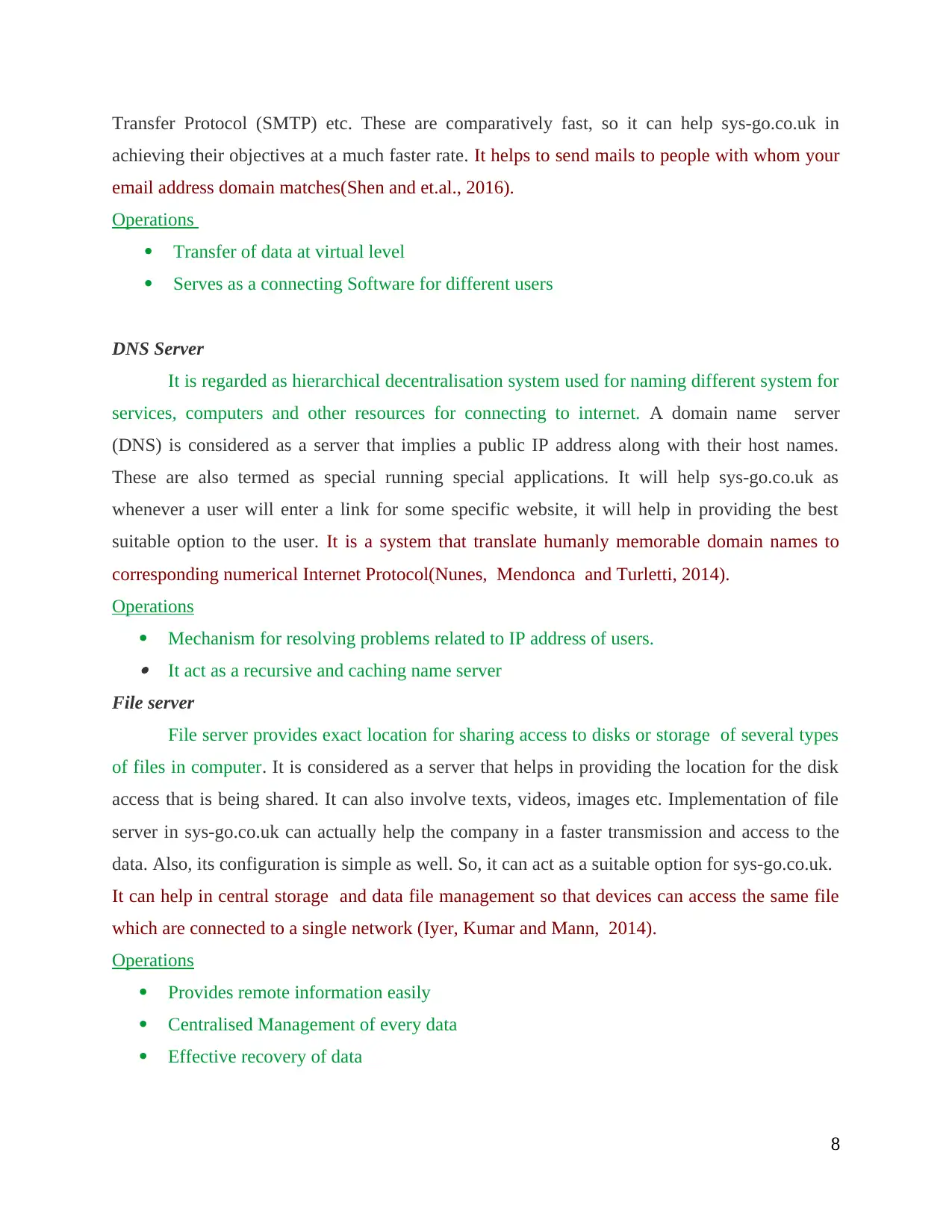
Transfer Protocol (SMTP) etc. These are comparatively fast, so it can help sys-go.co.uk in
achieving their objectives at a much faster rate. It helps to send mails to people with whom your
email address domain matches(Shen and et.al., 2016).
Operations
Transfer of data at virtual level
Serves as a connecting Software for different users
DNS Server
It is regarded as hierarchical decentralisation system used for naming different system for
services, computers and other resources for connecting to internet. A domain name server
(DNS) is considered as a server that implies a public IP address along with their host names.
These are also termed as special running special applications. It will help sys-go.co.uk as
whenever a user will enter a link for some specific website, it will help in providing the best
suitable option to the user. It is a system that translate humanly memorable domain names to
corresponding numerical Internet Protocol(Nunes, Mendonca and Turletti, 2014).
Operations
Mechanism for resolving problems related to IP address of users. It act as a recursive and caching name server
File server
File server provides exact location for sharing access to disks or storage of several types
of files in computer. It is considered as a server that helps in providing the location for the disk
access that is being shared. It can also involve texts, videos, images etc. Implementation of file
server in sys-go.co.uk can actually help the company in a faster transmission and access to the
data. Also, its configuration is simple as well. So, it can act as a suitable option for sys-go.co.uk.
It can help in central storage and data file management so that devices can access the same file
which are connected to a single network (Iyer, Kumar and Mann, 2014).
Operations
Provides remote information easily
Centralised Management of every data
Effective recovery of data
8
achieving their objectives at a much faster rate. It helps to send mails to people with whom your
email address domain matches(Shen and et.al., 2016).
Operations
Transfer of data at virtual level
Serves as a connecting Software for different users
DNS Server
It is regarded as hierarchical decentralisation system used for naming different system for
services, computers and other resources for connecting to internet. A domain name server
(DNS) is considered as a server that implies a public IP address along with their host names.
These are also termed as special running special applications. It will help sys-go.co.uk as
whenever a user will enter a link for some specific website, it will help in providing the best
suitable option to the user. It is a system that translate humanly memorable domain names to
corresponding numerical Internet Protocol(Nunes, Mendonca and Turletti, 2014).
Operations
Mechanism for resolving problems related to IP address of users. It act as a recursive and caching name server
File server
File server provides exact location for sharing access to disks or storage of several types
of files in computer. It is considered as a server that helps in providing the location for the disk
access that is being shared. It can also involve texts, videos, images etc. Implementation of file
server in sys-go.co.uk can actually help the company in a faster transmission and access to the
data. Also, its configuration is simple as well. So, it can act as a suitable option for sys-go.co.uk.
It can help in central storage and data file management so that devices can access the same file
which are connected to a single network (Iyer, Kumar and Mann, 2014).
Operations
Provides remote information easily
Centralised Management of every data
Effective recovery of data
8
Paraphrase This Document
Need a fresh take? Get an instant paraphrase of this document with our AI Paraphraser
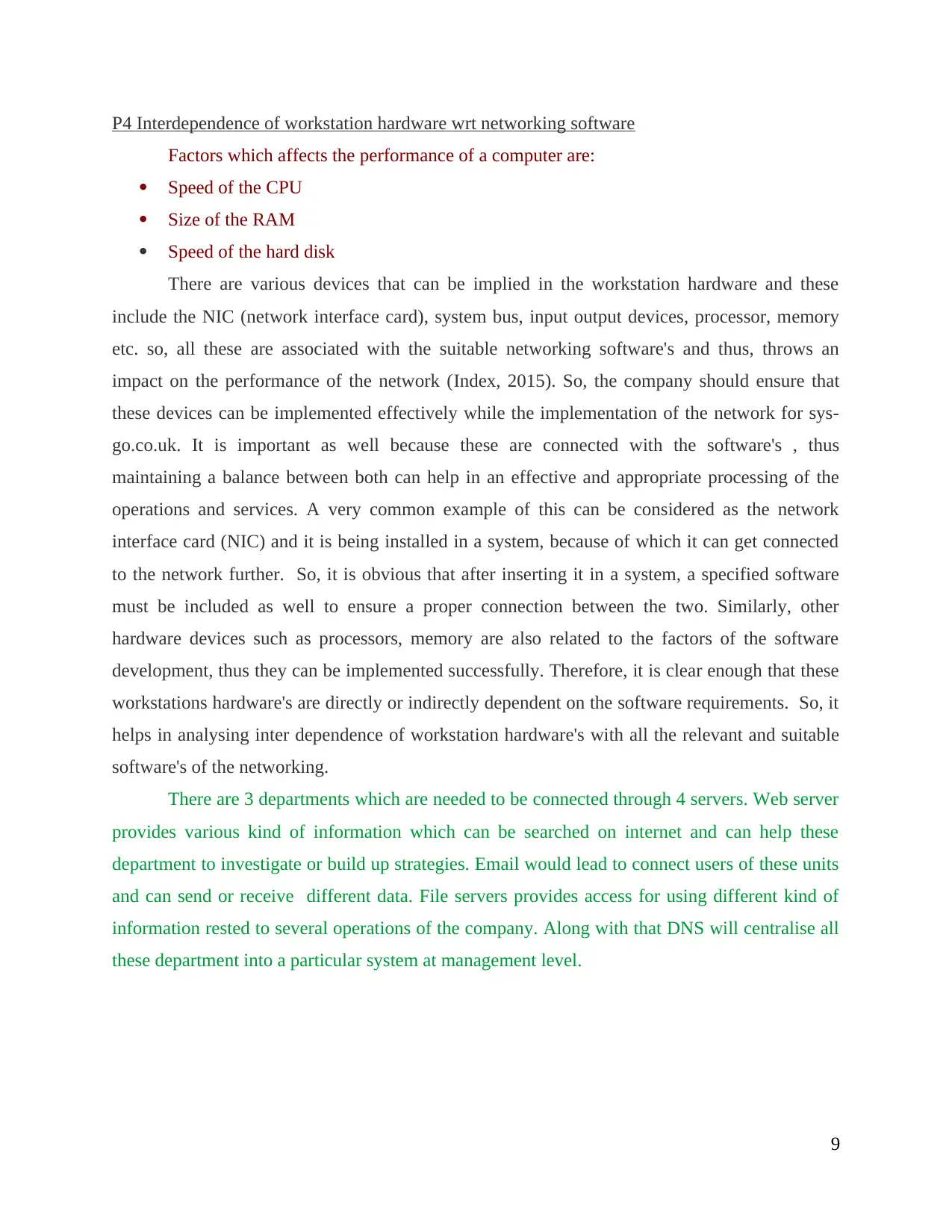
P4 Interdependence of workstation hardware wrt networking software
Factors which affects the performance of a computer are:
Speed of the CPU
Size of the RAM
Speed of the hard disk
There are various devices that can be implied in the workstation hardware and these
include the NIC (network interface card), system bus, input output devices, processor, memory
etc. so, all these are associated with the suitable networking software's and thus, throws an
impact on the performance of the network (Index, 2015). So, the company should ensure that
these devices can be implemented effectively while the implementation of the network for sys-
go.co.uk. It is important as well because these are connected with the software's , thus
maintaining a balance between both can help in an effective and appropriate processing of the
operations and services. A very common example of this can be considered as the network
interface card (NIC) and it is being installed in a system, because of which it can get connected
to the network further. So, it is obvious that after inserting it in a system, a specified software
must be included as well to ensure a proper connection between the two. Similarly, other
hardware devices such as processors, memory are also related to the factors of the software
development, thus they can be implemented successfully. Therefore, it is clear enough that these
workstations hardware's are directly or indirectly dependent on the software requirements. So, it
helps in analysing inter dependence of workstation hardware's with all the relevant and suitable
software's of the networking.
There are 3 departments which are needed to be connected through 4 servers. Web server
provides various kind of information which can be searched on internet and can help these
department to investigate or build up strategies. Email would lead to connect users of these units
and can send or receive different data. File servers provides access for using different kind of
information rested to several operations of the company. Along with that DNS will centralise all
these department into a particular system at management level.
9
Factors which affects the performance of a computer are:
Speed of the CPU
Size of the RAM
Speed of the hard disk
There are various devices that can be implied in the workstation hardware and these
include the NIC (network interface card), system bus, input output devices, processor, memory
etc. so, all these are associated with the suitable networking software's and thus, throws an
impact on the performance of the network (Index, 2015). So, the company should ensure that
these devices can be implemented effectively while the implementation of the network for sys-
go.co.uk. It is important as well because these are connected with the software's , thus
maintaining a balance between both can help in an effective and appropriate processing of the
operations and services. A very common example of this can be considered as the network
interface card (NIC) and it is being installed in a system, because of which it can get connected
to the network further. So, it is obvious that after inserting it in a system, a specified software
must be included as well to ensure a proper connection between the two. Similarly, other
hardware devices such as processors, memory are also related to the factors of the software
development, thus they can be implemented successfully. Therefore, it is clear enough that these
workstations hardware's are directly or indirectly dependent on the software requirements. So, it
helps in analysing inter dependence of workstation hardware's with all the relevant and suitable
software's of the networking.
There are 3 departments which are needed to be connected through 4 servers. Web server
provides various kind of information which can be searched on internet and can help these
department to investigate or build up strategies. Email would lead to connect users of these units
and can send or receive different data. File servers provides access for using different kind of
information rested to several operations of the company. Along with that DNS will centralise all
these department into a particular system at management level.
9
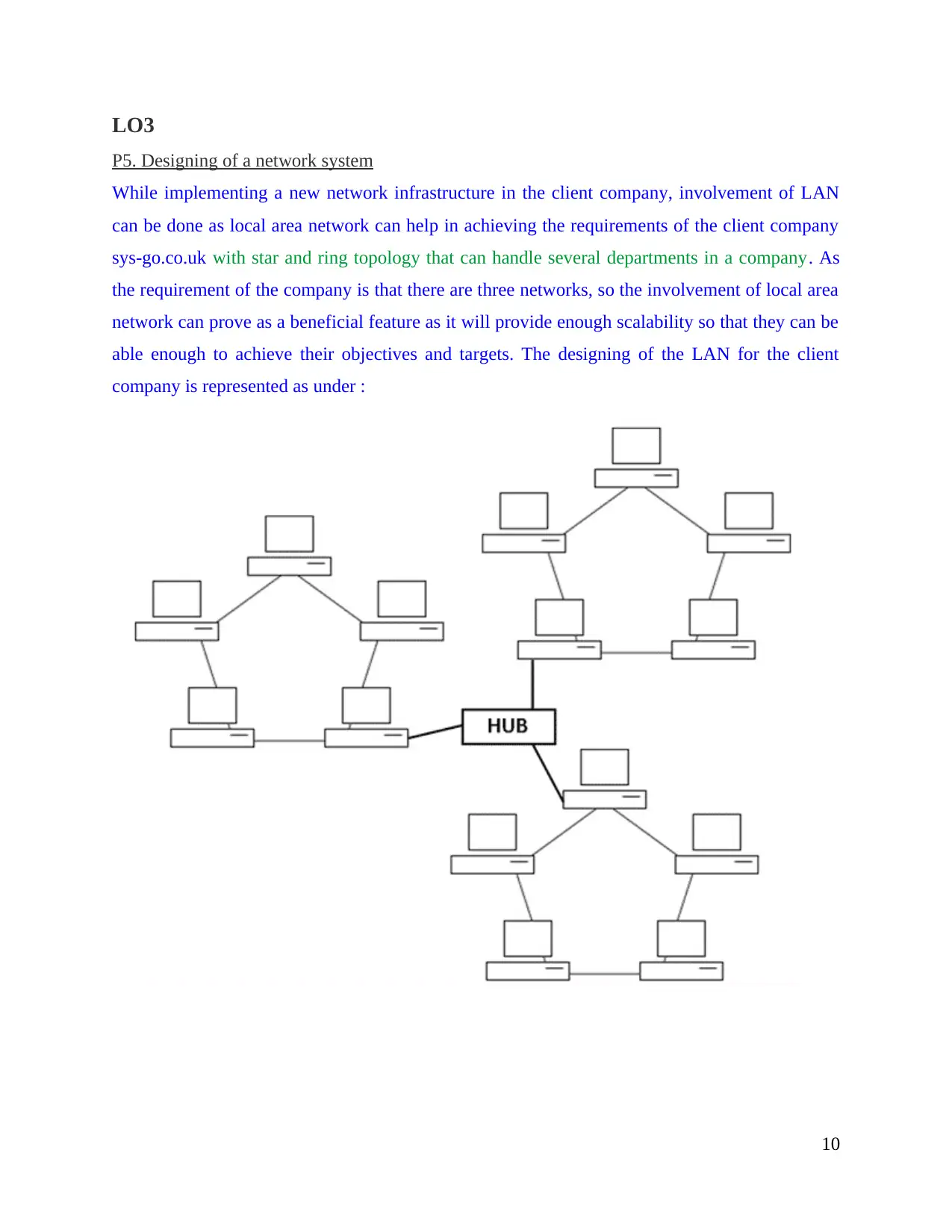
LO3
P5. Designing of a network system
While implementing a new network infrastructure in the client company, involvement of LAN
can be done as local area network can help in achieving the requirements of the client company
sys-go.co.uk with star and ring topology that can handle several departments in a company. As
the requirement of the company is that there are three networks, so the involvement of local area
network can prove as a beneficial feature as it will provide enough scalability so that they can be
able enough to achieve their objectives and targets. The designing of the LAN for the client
company is represented as under :
10
P5. Designing of a network system
While implementing a new network infrastructure in the client company, involvement of LAN
can be done as local area network can help in achieving the requirements of the client company
sys-go.co.uk with star and ring topology that can handle several departments in a company. As
the requirement of the company is that there are three networks, so the involvement of local area
network can prove as a beneficial feature as it will provide enough scalability so that they can be
able enough to achieve their objectives and targets. The designing of the LAN for the client
company is represented as under :
10
⊘ This is a preview!⊘
Do you want full access?
Subscribe today to unlock all pages.

Trusted by 1+ million students worldwide
1 out of 20
Related Documents
Your All-in-One AI-Powered Toolkit for Academic Success.
+13062052269
info@desklib.com
Available 24*7 on WhatsApp / Email
![[object Object]](/_next/static/media/star-bottom.7253800d.svg)
Unlock your academic potential
Copyright © 2020–2025 A2Z Services. All Rights Reserved. Developed and managed by ZUCOL.



